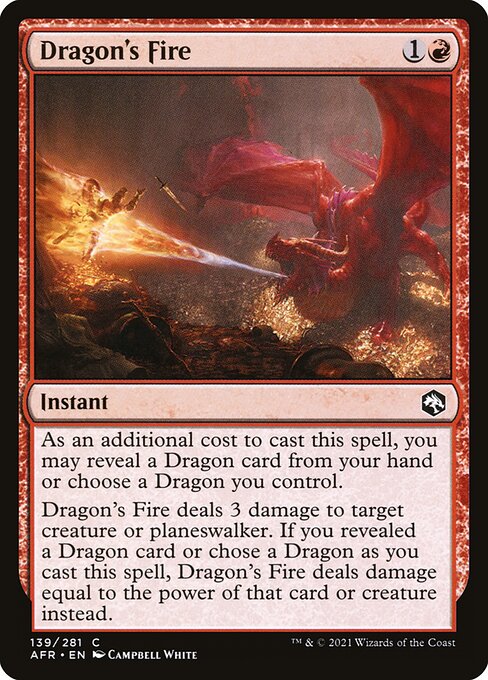
Image courtesy of Scryfall.com
Symbolism in the background art: fire, dragons, and the pulse of red
Magic: The Gathering has always wooed players with more than just numbers on a card; the art and the implied worldbuilding behind each spell pull us into a shared mythology. Dragon's Fire, a compact instant from Adventures in the Forgotten Realms, leans into red’s core themes—speed, risk, and blaze-lit resolve—and uses its background imagery to whisper about dragons without needing a long lore block. The color identity is pure red: a mana cost of {1}{R} and a quick, punchy effect that rewards bold choices. In the artwork, you sense embers trailing through a night-sky canvas and the silhouette of a dragon-like force steaming toward the target. It’s a visual shorthand for “act now, and trust your instincts”—an invitation to lean into the heat of the moment 🧙🔥.
Fire as a universal language
Red spells in MTG are frequently about momentum and direct impact, and Dragon's Fire is a textbook example. The spell’s baseline deals 3 damage to a creature or planeswalker, which by any standard is a reliable punt toward depleting an opposing threat. But the real spark—literally and figuratively—happens when you reveal a Dragon card from your hand or choose a Dragon you control as you cast. In that case, the damage scales with power: the flame becomes a mirror of the dragon’s own force. That shifting baseline embodies red’s most cinematic trait: risk with the reward dangled just out of reach, a push toward heroic, high-stakes plays 🎲⚔️. It’s not just a card; it’s a reminder that in memory and in battle, dragons magnify everything they touch.
The dragon motif and the Forgotten Realms setting
Adventures in the Forgotten Realms is a love letter to the D&D multiverse, and Dragon's Fire carries a whiff of that tabletop aura. The presence of dragons—whether you’ve drafted one from a hand or simply unleash a dragon’s power on the board—aligns with the set’s dragon-centric moments and the idea that a single, well-placed dragon can tilt the battlefield. Even as an instant, the card acts like a spell-wue of dragon lore: a fast, decisive strike backed by a deeper mythic cadence. The background art doesn’t depict a single, specific dragon sinuous through a cavern; rather, it evokes the idea of dragonfire as a living current. The flames curl like runes of old, the red haze suggests a realm where risk and legend mingle, and the whole scene hums with a sense that true power often hides in the margins of a well-told tale 🧙🔥🎨.
Color, power, and the art of doubling down
The background elements aren’t mere decoration; they’re a design language. The heavy use of red tones frames Dragon's Fire as a card meant for tempo and surprise. The “power” that can amplify the damage when you reveal a Dragon or pick a Dragon you control makes the artwork’s chaos feel earned—red’s penchant for risk isn’t just aesthetic; it’s a mechanical heartbeat. The card’s two-tiered payoff—flat 3 damage or amplified damage tied to dragon identity—mirrors the interplay between theme and execution: you choose when to reveal, you choose when to strike, and the art’s flames visually echo that moment of decision. For players who enjoy dragon-centric decks or mono-red strategies, this is a spicy reminder that the art and the mechanics are two sides of the same dragon’s wing 🐉💥.
Design, pacing, and how the art informs your play
Designer notes often reveal that a memorable instant needs a crisp cost curve and a dramatic payoff. Dragon's Fire hits the mark: a lean mana cost, a straightforward effect, and a potential swing that scales with your board. The background art reinforces pacing: in red, you want to move quickly, threaten lethal damage, and keep your opponent guessing. If you’re playing in a dragon-rich shell or with cards that reward dragon synergy, Dragon's Fire becomes a flexible burn spell—one that punishes opponents for overcommitting to their targets and rewards you for building toward a dragon-centric board state. The blend of artistic symbolism and mechanical momentum is why players remember both the moment they cast it and the image that accompanies it on the card face 🧙🔥⚔️.
Gameplay strategies for a dragon-tinged red shell
- Keep a dragon in mind as you cast. If you reveal one from your hand or have a dragon you control, your damage leaps from a reliable 3 to a power-based total, making it perfect for unexpected finishes.
- Pair with other red spells that clear blockers or push through damage; the instant-speed nature lets you respond to threats in combat or during your opponent’s turns.
- In formats where dragons show up frequently—whether casual or competitive—Dragon's Fire becomes a tempo tool that helps you squeeze value out of every dragon-centric draw.
- In Commander, think about dragon-heavy leads or synergies that maximize the power of dragons you cast or hold in hand, and time your reveal for maximum impact against a single stubborn threat.
For collectors and casual players alike, the AFR print of Dragon's Fire sits at a fascinating intersection: a common spell that can flip a game with the right dragon in play, a vivid piece of art that tightens the story around fire and flight, and a reminder that red’s flame is not just heat—it’s storytelling in motion 🧙🔥💎🎨.
“When the dragon wakes, so does the battlefield.”
As you ponder the throwback thrill of this art-forward card, consider how your own play space tells a story too. If you’re looking for a small, stylish way to keep your phone steady while you study deck builds or watch match recaps, there’s a handy desk companion I’ve been enjoying—the product below—designed to keep your device within reach as you plan your next dragon’s roar. It’s a tiny, practical nod to the way MTG blends function with fantasy.